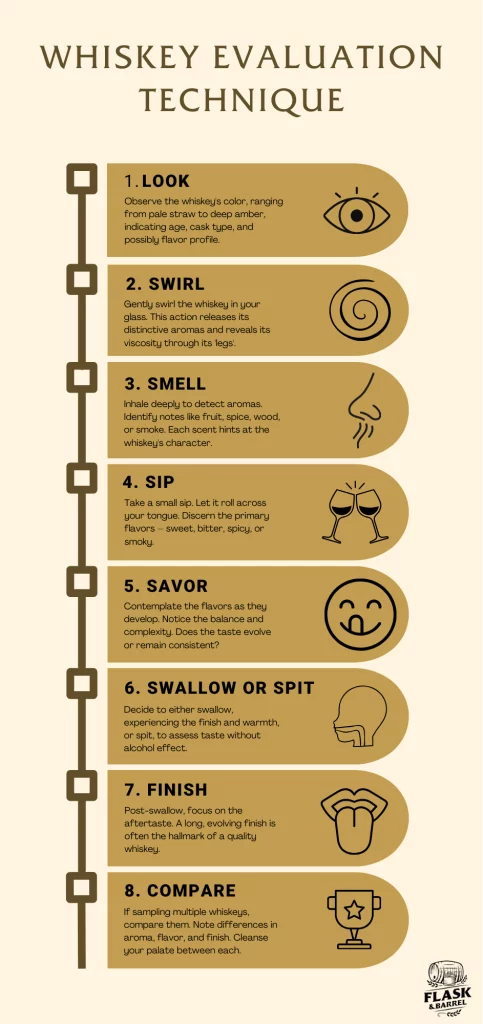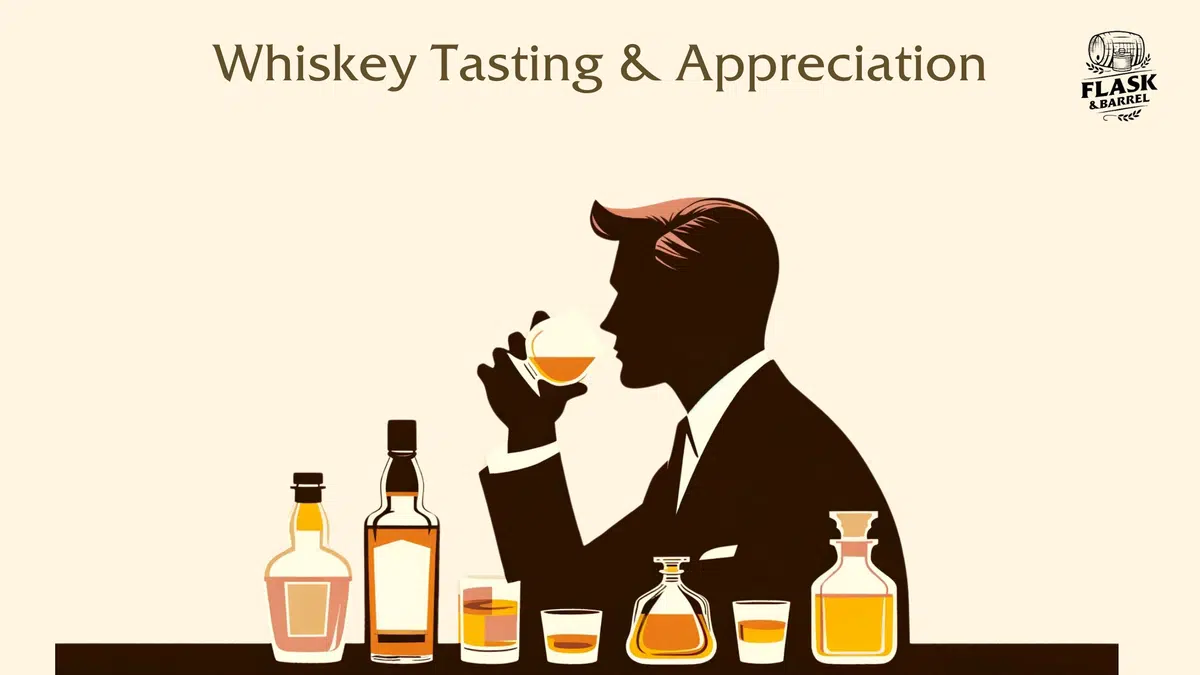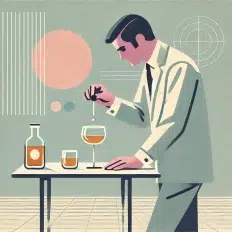Whiskey tasting is a nuanced process that involves a multi-sensory engagement with one of the world’s most revered spirits. By methodically observing the color, swirling to release aromas, sipping to assess flavor, and savoring the aftertaste, tasters can identify the distinctive characteristics that define various whiskey styles. The right tools, such as a proper whiskey glass and a tasting notes journal, enhance the experience, allowing for a thorough exploration of this complex beverage. Preparing for a whiskey tasting involves selecting a diverse range of whiskeys and creating an environment conducive to focused tasting. As enthusiasts develop their sensory vocabulary, terms like ‘body’, ‘finish’, ‘balance’, and ‘complexity’ become key descriptors in articulating their experiences. Through regular practice and learning from experts, anyone can refine their whiskey tasting skills, turning each tasting session into an opportunity for discovery and enjoyment.
What is Whiskey Tasting?
Whiskey tasting is the art of analysis and savoring of this storied spirit, conducted through a structured approach that examines its color, aroma, and taste. More than casual drinking, it’s an exploratory process designed to uncover the intricate flavors and scents that distinguish each whiskey. Aficionados partake in this ritual to elevate their understanding, benchmark varieties, and pinpoint their tastes.
This evaluative journey is meticulous, beginning with an assessment of the whiskey’s hue and culminating in the reflection on its aftertaste. Fundamentally, whiskey tasting is a purposeful exploration, a key to revealing the rich tapestry of sensory experiences that distillers weave into their creations.
Why do people taste whiskey?
People delve into whiskey tasting to immerse themselves in the spirit’s rich complexity and to honor the artistry that shapes each variant. It’s a quest for enlightenment, as aficionados explore how elements like distillation, maturation, and geography craft distinct flavors. Whiskey tasting is equally a social experience, creating a sense of community among those who share their insights and favorites. For connoisseurs, it’s about cultivating a sophisticated palate, transforming each tasting into a story of sensory discovery and time-honored tradition.
Individuals engage in whiskey tasting to:
- Appreciate the Craftsmanship: Whiskey tasting allows enthusiasts to recognize and value the skill and tradition involved in whiskey production, from the careful selection of ingredients to the intricate distillation and aging processes.
- Explore Flavor Profiles: Tasting provides the opportunity to explore and enjoy the vast array of flavors that whiskey can present, from the deep peatiness of an Islay Scotch to the sweet vanilla notes of a Kentucky Bourbon.
- Make Informed Purchasing Decisions: By understanding the nuances of different whiskeys, individuals can make educated choices when purchasing bottles for their collection or as gifts.
- Develop Sensory Skills: Whiskey tasting is an exercise in sensory development, enhancing one’s ability to detect subtle scents and flavors.
- Connect with Others: Whiskey tastings often serve as social gatherings where people can connect over shared experiences and discuss their findings.
- Celebrate Heritage: Whiskey tasting can be a way to connect with one’s cultural heritage or to explore the heritage of others, as whiskey is a spirit with deep roots in many regions around the world.
Beyond the sensory analysis, whiskey tasting acts as a communal bond, uniting aficionados in shared experiences and discussions. It’s a journey toward refining the palate, where each taste becomes a story woven from tradition and sensory exploration.
What are the Key Steps in Tasting Whiskey?
Engaging in whiskey tasting entails a structured sequence, initiating with observing the hue, hinting at its maturation and wood influence. The journey continues with nosing, as enthusiasts inhale deeply to unveil the spirit’s aromatic bouquet, indicative of its heritage and aging. The core of the experience is tasting, where a careful sip allows the flavors to unfold across the palate, revealing the whiskey’s full body and character. The process culminates in assessing the aftertaste, or the finish, ranging from a fleeting sweetness to an enduring complexity that echoes the spirit’s depth and craftsmanship.

Observing the Color
A whiskey’s color can provide valuable insights into its age and the type of cask used during maturation. Darker hues often suggest a longer aging process or the use of certain types of casks, such as sherry casks, which impart a deeper color and rich flavors.
Smelling the Aroma
Nosing the whiskey is a critical step that involves identifying the various aromas that contribute to the whiskey’s overall scent profile. Common aromas include vanilla, caramel, and fruit from the malt and aging process, as well as smoky or peaty notes from the malting process, particularly in Scotch whiskies.
Tasting the Whiskey
When tasting the whiskey, it is important to take a small sip and let it coat the palate. This allows the full range of flavors to be experienced, from the initial sweetness or spice on the tip of the tongue to the richer, deeper notes that develop in the mouth.
Assessing the Aftertaste
The aftertaste, or finish, is what remains after swallowing and can reveal much about the whiskey’s quality and complexity. A long, pleasant finish with evolving flavors is often indicative of a well-crafted whiskey.
By following these key steps, tasters can systematically explore and appreciate the intricate flavors and aromas that make each whiskey unique.
What Tools are Needed for Whiskey Tasting?
To fully appreciate whiskey tasting, certain tools are indispensable. A Glencairn glass, with its wide bowl and tapered mouth, is designed to enhance the aroma and flavor experience. A tasting notes journal is key for documenting impressions and tracking the evolution of one’s palate. For those looking to modulate the intensity, water can be added to unlock new flavors and aromas, making it a subtle but powerful tool in whiskey tasting.
Whiskey Glass or Glencairn Glass
The right vessel is essential; a Glencairn glass, with its contour designed to amplify the whiskey’s aromatics, is the connoisseur’s choice for an optimal tasting experience, concentrating the bouquet and flavors for thorough evaluation.
Tasting Notes Journal
A tasting notes journal is indispensable for the serious taster. It serves as a personal ledger for documenting impressions and flavor profiles, providing a reference point for future tastings and palate development.
Water (Optional)
While not mandatory, a few drops of water can significantly enhance the tasting experience. It can unlock flavor compounds, reduce astringency, and allow a more nuanced appreciation of the whiskey’s character.
| Tool | Purpose | Details |
|---|---|---|
| Glencairn Glass | Enhancing aroma and flavor | The tapered mouth focuses the aroma, while the wide bowl allows for easy swirling. |
| Standard Whiskey Glass | General tasting | A wider rim may disperse aromatics more, suitable for less intense nosing. |
| Snifter | Concentrating aromas | A large bowl with a narrow top, designed to trap and concentrate aromas. |
| Tasting Notes Journal | Documenting impressions and flavor profiles | Use structured sections for appearance, nose, palate, and finish. Include date and whiskey name. |
| Water | Modulating intensity and unlocking flavors | Add a few drops to whiskey to open up the flavors, especially for cask strength varieties. |
| Pipette or Dropper | Precise water addition | Allows for controlled dilution to achieve the desired flavor profile. |
| Spittoon | Responsible tasting | A receptacle for spitting out whiskey after tasting, especially during extensive sessions. |
| Tasting Mat | Organizing tasting sessions | A mat with designated spots for each glass can help keep track of multiple samples. |
| Flavor Wheel | Identifying and articulating flavors and aromas | A visual guide that helps tasters recognize and describe the flavors they are experiencing. |
By using this detailed markdown table, the section becomes more informative and exhaustive, providing readers with a clear understanding of the tools needed for whiskey tasting and how to use them effectively.
How Does One Prepare for a Whiskey Tasting?
Preparing for a whiskey tasting entails curating a varied selection of whiskeys, which allows tasters to experience a spectrum of flavors and distillation styles. The environment should be quiet and neutral, free from any disruptive scents or noises that could interfere with the sensory evaluation. Prior to the tasting, it’s crucial to cleanse the palate with water or unsalted crackers, ensuring a fresh start for each whiskey and an accurate assessment of its unique profile.
Selecting a Variety of Whiskeys
A thoughtful selection encompassing various ages, regions, and distillation methods is essential, offering a comprehensive exploration of whiskey’s complex landscape.
Ensuring a Proper Setting
Creating an ideal environment is crucial; it should be serene and neutral, allowing the nuances of each whiskey to be experienced without external sensory interference.
Cleansing the Palate
To maintain an objective tasting experience, it’s important to clear the palate with neutral water or plain crackers, ensuring that each whiskey can be tasted freshly and without prejudice.
| Preparation Aspect | Criteria/Advice | Details |
|---|---|---|
| Selecting Whiskeys | Variety in age, region, and type | Include a range from young to aged whiskeys, different regions (e.g., Scotch, Bourbon), and various types (e.g., single malt, blended). |
| Setting | Controlled environment | Choose a space with minimal noise, neutral odors, and adequate lighting. Comfortable seating and a clean surface for glasses and tools. |
| Palate Cleansers | Neutral and refreshing | Offer unsalted crackers, bread, or still water to cleanse the palate between tastings. |
By using this detailed markdown table, the section becomes more informative and exhaustive, providing readers with clear guidelines on how to prepare for a whiskey tasting. This structured approach ensures that each aspect of preparation is considered, leading to a more enjoyable and educational tasting experience.
What are Common Whiskey Tasting Terms?
When delving into whiskey tasting, becoming familiar with specific terminology is crucial. The body of a whiskey alludes to its texture and fullness on the palate. The finish is the lasting impression a whiskey leaves, characterized by its flavor persistence. Evaluating the balance involves discerning how the flavors meld and complement each other. Lastly, complexity captures the breadth and depth of sensory notes present in the whiskey. These terms are fundamental for effectively communicating and understanding the subtleties of whiskey tasting.
| Term | Definition | Example |
|---|---|---|
| Body | The perception of weight and fullness of the whiskey on the palate. | “The whiskey has a heavy body with a creamy texture, indicating a higher oil content.” |
| Finish | The lingering sensation and flavors remaining after swallowing the whiskey. | “The finish is long and warm, with a spicy aftertaste that speaks to its quality.” |
| Balance | The harmony between the different sensory elements of the whiskey. | “This whiskey is well-balanced, with the sweetness of vanilla complementing the oakiness.” |
| Complexity | The range and intricacy of flavors and aromas in the whiskey. | “The whiskey’s complexity is evident, with layers of fruit, spice, and floral notes.” |
By using this detailed markdown table, the section becomes more informative and exhaustive, providing readers with clear definitions and examples of common whiskey tasting terms. This structured approach ensures that each term is understood in context, leading to a more enriching and educational tasting experience.
How Can One Develop Their Whiskey Tasting Skills?
Enhancing one’s whiskey tasting acumen is an exercise in sensory enhancement and continuous learning. Regular practice is essential, as it hones the ability to discern and appreciate the subtleties of different whiskeys. Participation in tastings and workshops offers guided experiences and exposure to diverse whiskey profiles. Gleaning knowledge from experts in the field accelerates the learning curve, providing deeper insights and a more nuanced understanding of whiskey’s complexities.
Regular Practice
Engaging in regular practice is the cornerstone of enhancing one’s whiskey palate. It allows for the development of a memory bank of flavors and aromas, which is crucial for identifying the subtle nuances in different whiskeys.
Attending Tastings and Workshops
Participation in tastings and workshops provides invaluable opportunities to sample a breadth of whiskeys and learn systematic approaches to tasting under the guidance of seasoned professionals.
Learning from Experts
Learning from experts offers a wealth of knowledge, as these connoisseurs can impart specialized expertise and personal insights that deepen one’s appreciation and understanding of whiskey.





